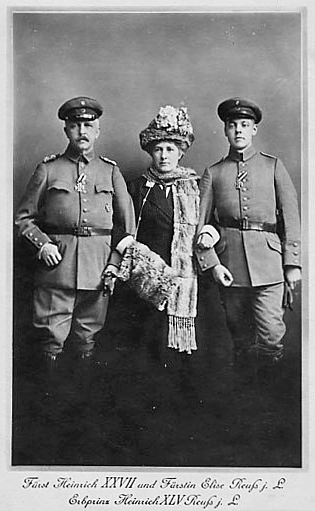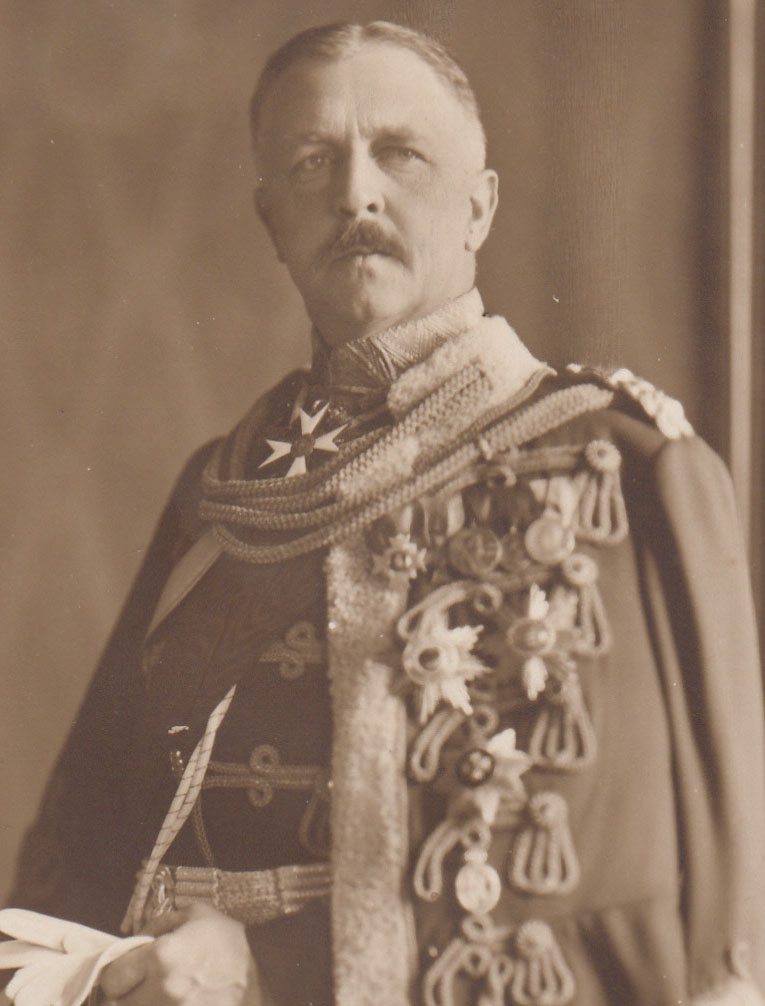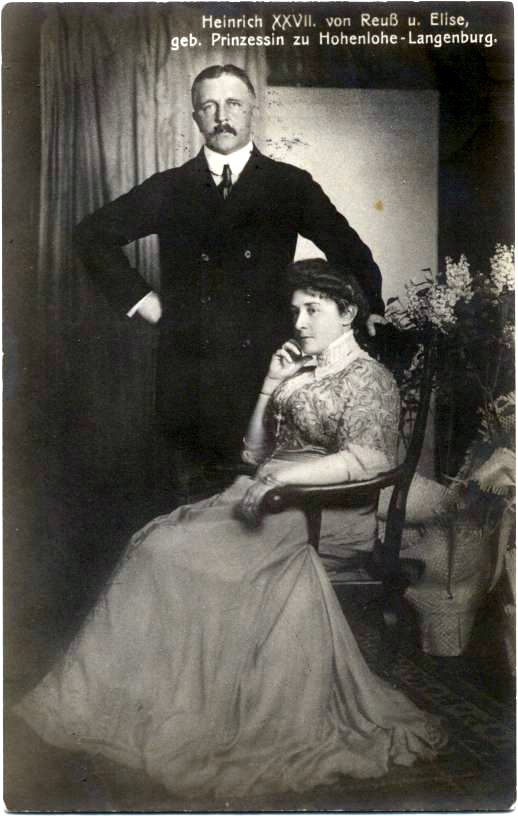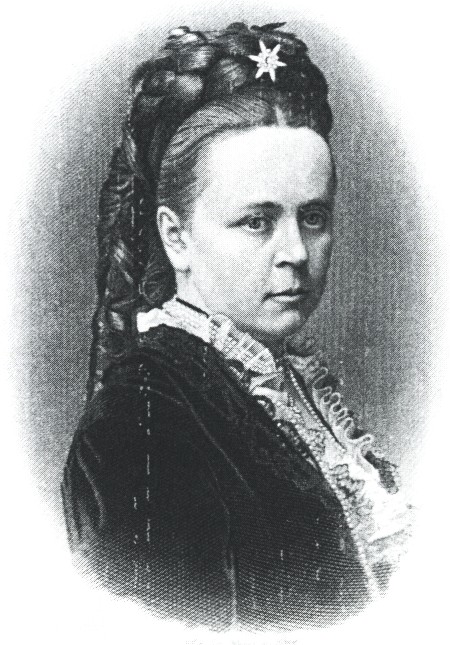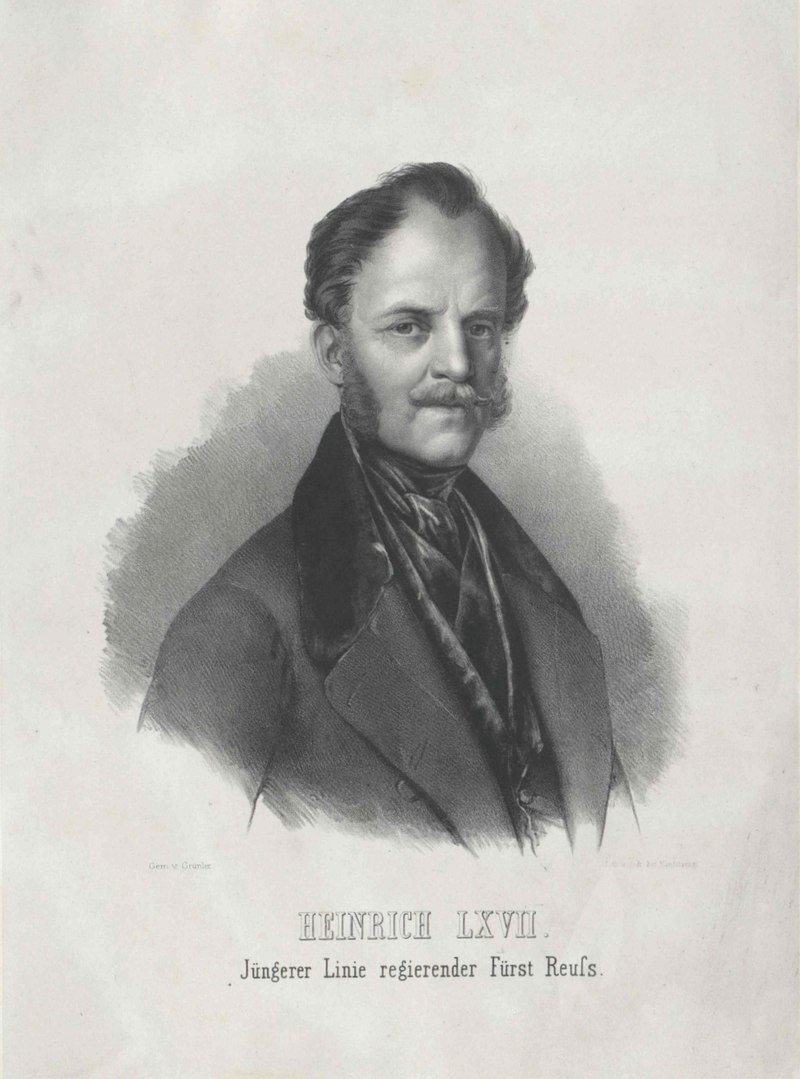by Susan Flantzer
© Unofficial Royalty 2023

Wilhelmine Luise of Nassau-Weilburg, Princess Reuss of Greiz; Credit – Wikipedia
Note about the Reuss numbering system: All males of the House of Reuss were named Heinrich plus a number. In the Reuss-Greiz, Elder Line, the numbering covered all male children and the numbers increased until 100 was reached and then started again at 1. In the Reuss-Gera, Younger Line, the system was similar but the numbers increased until the end of the century before starting again at 1. This tradition was seen as a way of honoring Holy Roman Emperor Heinrich VI (reigned 1191 – 1197) who had benefitted the family. Therefore, the Roman numerals seen after names are NOT regnal numbers.
Principality of Reuss-Greiz: The House of Reuss began their rule circa 1010. Heinrich XI, Count Reuss of Greiz, Lower-Greiz (Untergreiz) and Upper-Greiz (Obergreiz) was elevated to princely status in 1778 and then used the title of Prince Reuss, Older Line, or Prince Reuss of Greiz.
Heinrich XXIV, the last Prince Reuss of Greiz, succeeded his father in 1902 but was unable to rule because of his physical and mental disabilities as a result of an accident in his childhood. Instead, a Regent ruled the Principality of Reuss-Greiz: Heinrich XIV, 4th Prince Reuss of Gera from 1901 – 1913, and then his son Heinrich XXVII, 5th and last Prince Reuss of Gera from 1913 – 1918.
On November 11, 1918, the Regent, Heinrich XXVII, Prince Reuss of Gera (Younger Line) abdicated in the name of the disabled Heinrich XXIV, 6th Prince Reuss of Greiz. After the abdication, Heinrich XXIV retained the right of residence of the Lower Castle in Greiz and lived there until his death. The territory that encompassed the Principality of Reuss-Greiz is now in the German state of Thuringia.
********************
The wife of Heinrich XIII, 2nd Prince Reuss of Greiz, Princess Wilhelmine Luise of Nassau-Weilburg was born on September 28, 1765, in The Hague, then in the Dutch Republic, now in The Netherlands. She was the fourth of the nine children and the second of the five daughters of Karl Christian, Duke of Nassau-Weilburg and Princess Carolina of Orange-Nassau. Wilhelmine Luise’s paternal grandparents were Karl August, Prince of Nassau-Weilburg and Princess Auguste Friederike of Nassau-Idstein (link in German). Her maternal grandparents were Willem IV, Prince of Orange and Anne, Princess Royal (daughter of King George II of Great Britain).

Caroline of Orange-Nassau and her children, circa 1778; Left to Right: Karoline, Caroline of Orange-Nassau, Amalia, Karl, Wilhelmine Luise, Marie, and Friedrich Wilhelm; Credit – Wikipedia
Wilhelmine Luise had a total of eight siblings but only five survived childhood. Her sister Amalia is an ancestor of the Dutch Royal Family and her sister Henriette is an ancestor of the British House of Windsor through Queen Mary, the wife of King George V of the United Kingdom:
- Georg, Hereditary Prince of Nassau-Weilburg (1760 – 1762), died in early childhood
- Ludwig, Hereditary Prince of Nassau-Weilburg (1761 – 1770), died in childhood
- Princess Marie of Nassau-Weilburg (1764 – 1802), unmarried, a deaconess at the secular Protestant abbeys in Quedlinburg and Herford in the Duchy of Saxony
- Friedrich Wilhelm, Prince of Nassau-Weilburg (1768 – 1816), married Louise Isabelle of Kirchberg, had four children
- Princess Karoline of Nassau-Weilburg (1770 – 1828), married Karl Ludwig, Prince of Wied, no children
- Prince Karl of Nassau-Weilburg (1775 – 1807), unmarried
- Princess Amalia of Nassau-Weilburg (1776 – 1841), married (1) Victor II, Prince of Anhalt-Bernburg-Schaumburg-Hoym, had four daughters including Emma of Anhalt-Bernburg-Schaumburg-Hoym who married Georg II, Prince of Waldeck and Pyrmont – their granddaughter Emma of Waldeck-Pyrmont was the second wife of King Willem III of the Netherlands and the mother of Queen Wilhelmina of the Netherlands (2) Baron Friedrich von Stein-Liebenstein zu Barchfeld, no children
- Princess Henriette of Nassau-Weilburg (1780 – 1857), married Duke Ludwig Friedrich of Württemberg, had four children including Pauline who married her first cousin King Wilhelm I of Württemberg, and Alexander whose morganatic marriage to Claudine Rhedey, a Hungarian countess, caused him to lose his succession rights to the Württemberg throne and his children to lose the right to use the Württemberg name. In 1863, Alexander’s children were elevated by his first cousin and brother-in-law King Wilhelm I of Württemberg to the rank of Princes and Princesses of Teck. One of those children was Prince Francis, Duke of Teck, the father of Princess Victoria Mary of Teck, later Queen Mary, the wife of King George V of the United Kingdom.
The family lived in The Hague, then in the Dutch Republic, now in the Netherlands, mostly because Wilhelmine Luise’s father Karl Christian, Prince of Nassau-Weilburg served in the Dutch army. However, because Carolina of Orange-Nassau, Wilhelmine Luise’s mother, was one of the four successive regents for her only surviving sibling Willem V, Prince of Orange, it was also necessary that the family stay in The Hague. Carolina and Willem V’s father Willem IV, Prince of Orange had died at age 40 and was succeeded by his son Willem (V) who was only three years old. Willem V would not reach his majority for fifteen years, and until then he had four successive regents. In 1769, Wihelmine Luise’s family moved to Weilburg in her father’s Principality of Nassau-Weilburg, now in the German state of Hesse, but in 1773, Wilhelmine Luise’s father Karl Christian was appointed Governor of Maastricht in the Dutch Republic, and so the family once again returned to the Dutch Republic. In 1784, Wilhelmine Luise’s father resigned as Governor of Maastricht and the family moved back to Weilburg.

Heinrich XIII, 2nd Prince Reuss of Greiz, Wilhelmine Luise’s husband; Credit – Wikipedia
Twenty-year-old Wilhelmine Luise married thirty-eight-year-old Heinrich XIII, the heir to the throne of the Principality of Reuss-Greiz, on January 9, 1786, in Kirchheim, Principality of Nassau-Weilburg, now in Rhineland-Palatinate, Germany.
Wilhelmine Luise and Heinrich XIII had four sons:
- Prince Heinrich XVIII Reuss of Greiz (born and died 1787)
- Heinrich XIX, 3rd Prince Reuss of Greiz (1790 – 1836), his father’s successor, married Princess Gasparine of Rohan-Rochefort, had two daughters
- Heinrich XX, 4th Prince Reuss of Greiz (1794 – 1859), his brother’s successor, married (1) Princess Sophie of Löwenstein-Wertheim-Rosenberg, no children (2) Princess Caroline Amalie of Hesse-Homburg, had five children
Wilhelmine Luise’s husband Heinrich XIII served in the Austrian Army. He attained the rank of General Feldzeugmeister, commander-in-chief of the artillery, one of the highest officers in the army. Heinrich XIII was a close personal friend of Holy Roman Emperor Joseph II. In 1789, Heinrich XIII represented the Holy Roman Empire at the court of the Kingdom of Prussia.
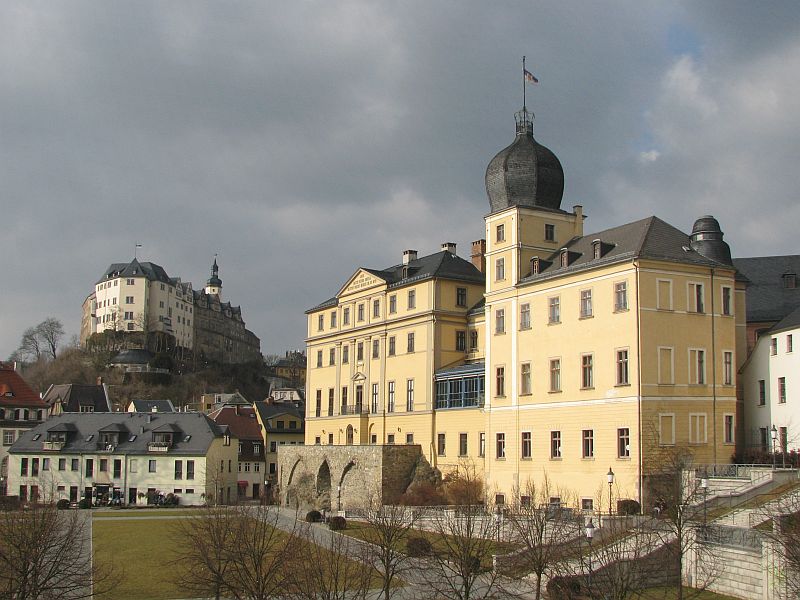
The Lower Castle in Greiz, with the Upper Castle in the background; Credit – Von Wolfgang Pehlemann Wiesbaden Germany – Selbst fotografiert, CC BY-SA 3.0 de, https://commons.wikimedia.org/w/index.php?curid=32945991
Upon his father’s death in 1800, Heinrich XIII succeeded as Prince Reuss of Greiz. On April 6, 1802, a large fire destroyed much of Greiz, the capital of the Principality of Reuss-Greiz, now in the German state of Thuringia. Approximately 430 buildings were destroyed. Many other buildings were demolished to prevent the fire from spreading. Heinrich XIII oversaw the rebuilding of Greiz in the neoclassical style and moved his residence from the Obere Schloss (link in German) (Upper Castle) to the Untere Schloss (link in German) so he could be closer to the people and social life of Greiz.

Stadtkirche St. Marien in Greiz; Credit – Von Tilman2007 – Eigenes Werk, CC BY-SA 3.0, https://commons.wikimedia.org/w/index.php?curid=41473525
Heinrich XIII, 2nd Prince Reuss of Greiz died on January 29, 1817, aged 69, in Greiz, Principality of Reuss-Greiz. He was buried at the Stadtkirche St. Marien (link in German) now in Greiz, Thuringia, Germany. Wilhelmine Luise survived her husband by twenty years, dying on October 10, 1837, aged 72, in Greiz, Principality of Reuss-Greiz. She was buried with her husband.
This article is the intellectual property of Unofficial Royalty and is NOT TO BE COPIED, EDITED, OR POSTED IN ANY FORM ON ANOTHER WEBSITE under any circumstances. It is permissible to use a link that directs to Unofficial Royalty.
Works Cited
- Charles Christian, Prince of Nassau-Weilburg (2023) Wikipedia. Available at: https://en.wikipedia.org/wiki/Charles_Christian,_Prince_of_Nassau-Weilburg (Accessed: 21 August 2023).
- Flantzer, Susan. (2020) Heinrich XIII, 2nd Prince Reuss of Greiz, Unofficial Royalty. Available at: https://www.unofficialroyalty.com/heinrich-xiii-prince-reuss-of-greiz/ (Accessed: 21 August 2023).
- Flantzer, Susan. (2016) Willem V, Prince of Orange, Unofficial Royalty. Available at: https://www.unofficialroyalty.com/william-v-prince-of-orange/ (Accessed: 21 August 2023).
- Louise, Princess Reuss of Greiz (2023) Wikipedia. Available at: https://en.wikipedia.org/wiki/Louise,_Princess_Reuss_of_Greiz (Accessed: 21 August 2023).
- Princess Carolina of Orange-Nassau (2023) Wikipedia. Available at: https://en.wikipedia.org/wiki/Princess_Carolina_of_Orange-Nassau (Accessed: 21 August 2023).
- Вільгельміна Луїза Нассау-Вайльбурзька (Luise of Nassau-Weilburg) (2023) Wikipedia (Ukrainian). Available at: https://uk.wikipedia.org/wiki/%D0%92%D1%96%D0%BB%D1%8C%D0%B3%D0%B5%D0%BB%D1%8C%D0%BC%D1%96%D0%BD%D0%B0_%D0%9B%D1%83%D1%97%D0%B7%D0%B0_%D0%9D%D0%B0%D1%81%D1%81%D0%B0%D1%83-%D0%92%D0%B0%D0%B9%D0%BB%D1%8C%D0%B1%D1%83%D1%80%D0%B7%D1%8C%D0%BA%D0%B0 (Accessed: 21 August 2023).









